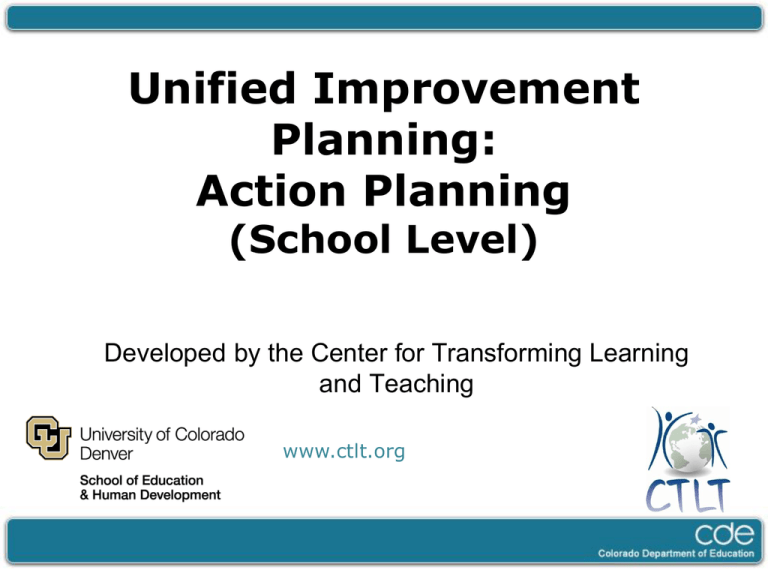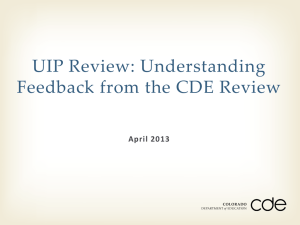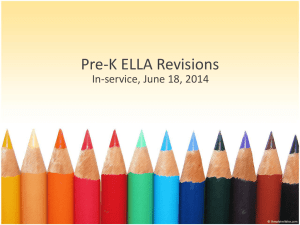Action Planning Presentation
advertisement

Unified Improvement Planning: Action Planning (School Level) Developed by the Center for Transforming Learning and Teaching www.ctlt.org Session Purpose Ensure planning teams are prepared develop action plans as part of unified improvement planning. Materials Norms The standards of behavior by which we agree to operate while we are engaged in learning together. Session Outcomes Engage in handson learning activities and dialogue with colleagues. Access additional resources. Complete followup activities. • Describe a major improvement strategy that responds to the root cause of a performance challenge. • Plan to identify additional major improvement strategies and associated action steps. • Identify implementation benchmarks. Agenda Major Improvement Strategies Action Steps Plan for Progress Monitoring Implementation Benchmarks Unified Improvement Planning Processes Gather and Organize Data Review Current Performance Describe Significant Trends Prioritize Performance Challenges Identify Root Causes Set Performance Targets Identify Major Improvement Strategies Identify Interim Measures Identify Implementation Benchmarks Action Planning Major Improvement Strategies • Work with a partner to review: – Action Planning Form (UIP template, p. 11) and – Action Planning Form: Identify Major Improvement Strategies (UIP Handbook, p. 18) – Unified Improvement Plan Quality Criteria: Major Improvement Strategies (UIP Handbook, p. 50). • Be prepared to answer these questions: – To what must major improvement strategies respond? – What information must be included about each major improvement strategy? Major Improvement Strategies • Respond to root causes of the performance problems the school/district is attempting to remedy. • Action steps are smaller activities that fit within larger major improvement strategies. • Improvement Strategies and Action Steps must be associated with resources, people, and time. Turnaround Schools • For Turnaround schools, Major Improvement Strategies must include one of the seven Turnaround Options. • Some school with Turnaround Plans may be in the second or third year of implementing one of these options. Reviewing Turnaround Options • Work with a partner. Consider Turnaround Options. • Silently read one row in the chart (individually). • When each partner has completed a row, look up and “say something.” Something might be a question, a brief summary, a key point, an interesting idea or personal connection to the text. • Continue until you complete all of the rows in the chart. How to Identify Major Improvement Strategies 1. Focus on a priority performance challenge and the root cause(s). 2. Consider research. 3. Identify a desired future (if action is taken to dissolve root cause(s), from the perspective of various local stakeholders). 4. Identify strategies to get to the desired future. 5. Articulate a Theory of Action (If, then, and then). 6. Re-write as a major improvement strategy. Developing Major Improvement Strategies • Consider “Developing Major Improvement Strategies,” • This is both a note-catcher and job aide for developing major improvement strategies. Focusing Major Improvement Strategies • Dissolving root causes of performance challenges • Performance challenge(s) and associated root cause. • Frame the development of major improvement strategies. Contextualize with Research • Research should provide the context within which schools and districts choose major improvement strategies. • Consider: – Failed Turnaround Strategies – What Rural Districts are Doing – Breaking the Habit of Low Performance Case Studies How to Identify Major Improvement Strategies 1. Focus on a priority performance challenge and the root cause(s). 2. Consider research. 3. Identify a desired future (if action is taken to dissolve root cause(s), from the perspective of various local stakeholders). 4. Identify strategies to get to the desired future. 5. Articulate a Theory of Action (If, then, and then). 6. Re-write as a major improvement strategy. Describe your Desired Future • If root causes are eliminated . . . • What will these different groups be doing differently? – – – – Students Staff members Leadership team Parents / Community • Examples: – All students monitor the progress of their learning towards grade level expectations on a weekly basis and set personal learning goals. – Teachers daily use data about learning formatively to refocus instruction on their students’ needs. – Staff members consistently implement identified practices in effective literacy instruction. Describing the desired future • Create “Desired Future.” • Add details to describe the desired future. • Consider the perspectives of the following audiences: – – – – Students Staff members Leadership team Parents / Community How to Identify Major Improvement Strategies 1. Focus on a priority performance challenge and the root cause(s). 2. Consider research. 3. Identify a desired future (if action is taken to dissolve root cause(s), from the perspective of various local stakeholders). 4. Identify strategies to get to the desired future. 5. Articulate a Theory of Action (If, then, and then). 6. Re-write as a major improvement strategy. Research Brainstorm major improvement strategies in this outer circle Desired Future Root Cause Case Studies Turnaround Options Flow maps used with permission from Thinking Maps, Inc. Specific training required before implementing Thinking Maps. For more information, visit www.thinkingmaps.com. Brainstorm potential STRATEGIES • Focus on one root cause. Create a circle map with “Root Cause(s) ____in the middle. • Include the preferred future in the frame. • Brainstorm major strategies that would dissolve the root cause(s) – One strategy per post-it note. – Stay at the major strategy level. – Post all ideas on the circle map. • Prioritize your strategies (indicate highest priority strategies by underlining or circling them). How to Identify Major Improvement Strategies 1. Focus on a priority performance challenge and the root cause(s). 2. Consider research. 3. Identify a desired future (if action is taken to dissolve root cause(s), from the perspective of various local stakeholders). 4. Identify strategies to get to the desired future. 5. Articulate a Theory of Action (If, then, and then). 6. Re-write as a major improvement strategy. Articulate a THEORY of ACTION • For your priority improvement strategies, articulate a theory of action. • Format: – … [teacher / adult actions] – Then … [student behaviors / student learning / etc.] – And … [measures for assessing growth THEORY of ACTION example If… Then… And… This converts an explanation or process into an essential instructional practice. This describes what students will be able to do as a result. This identifies how to assess the implementation of teacher practices and student learning. If teachers fully …Then students will teach and assess the have common, spiraling new K-5 year-end expectations and writing outcomes and vocabulary, which will share them with improve their students… achievement… …And ongoing teacher records will show the progress students are making towards meeting year-end writing outcomes. Theory of Action • Articulate your Theory of Action • Make sure to include If. . ., Then. . ., And. . • Write your theory of action as a major improvement strategy. Agenda Major Improvement Strategies Action Steps Plan for Progress Monitoring Implementation Benchmarks Action Steps Action Steps Timeline Key Personnel Resources Implementation Benchmarks Action steps must be defined for each major improvement strategy. Implementing all of the action steps = implementing the major improvement strategy. What are Action Steps? • A number of criteria for action steps are program specific. • Review Unified Improvement Plan Quality Criteria: Action Steps, (UIP Handbook, p. 51). • Consider: Based on state accountability plan type and program designations, what action step criteria apply to my district? • CDE is developing UIP Addenda to facilitate school and district efforts to meet federal requirements through the UIP (UIP Handbook, p. 23) External Vendors • If the school/district will employ external vendors (see for example turnaround option iii), the plan should include: – Major activity undertaken by the external vendor, – Timeline for those activities, – Resources that will pay for the external vendor, and – Implementation benchmarks for the activities of the external vendor. How to develop Action Steps • Do a force field analysis in reference to your major improvement strategy – Identify driving forces – Identify restraining forces – Prioritize restraining forces. • Identify action steps that would eliminate or weaken your restraining forces (in priority order). • Take out “Force Field Analysis” Force-Field Analysis: Mind-set • Change is a dynamic process that generates energy and movement in individuals and in organizations. • Change can be viewed as a dynamic between forces seeking to maintain a status quo, and forces seeking to drive the status quo to change. • When driving forces are the stronger force, change moves forward. When restraining forces are stronger or equal to the driving forces, movement can be blocked or stalled. – Ken Lewin (Force Field Analysis developer). Page 47 What does a Force-Field Analysis do? 1. helps people to think together about all the facets of a desired change; 2. develops consensus as an environmental scan, enabling participants to articulate key dynamics relevant to an upcoming change 3. aids in comparing the positives and negatives of a situation; 4. encourages creative thinking; 5. promotes agreement about the relative priority of restraining versus driving factors; and it 6. provides a starting point for the selection of action steps. Page 47 When should a force field analysis be used? • after major improvement strategies have been identified • when it is unclear which actions to prioritize • when planners want to put new actions into the existing context • when a team wants to maximize the success of a new venture either by approaching change from the perspective of strengthening driving forces or by reducing restraining forces. How is a force field analysis conducted? 1. Select a major improvement strategy. 2. Brainstorm and list on the left side of a T-chart the existing forces/factors that support or are driving the school TOWARD the strategy. 3. Brainstorm and list on the right the existing forces/factors that are holding the school back or driving it AWAY from the strategy. 4. Clarify, explain, reach agreement on the items that have been charted. 5. Eliminate duplications and combine items as needed. 6. Rank the “restraining forces” from most to least important (can be done individually and combined, or as a group) 7. Begin identifying action steps by addressing the items with the highest ranking numbers. Activity: Force Field Analysis • Review Force Field Analysis, section titled “How to engage in force field analysis” • Use the force field analysis note catcher • Write your major improvement strategy at the top of the page. • Brainstorm driving forces and restraining forces (15 min). • Prioritize the restraining forces (5 min). Develop Action Steps • Start with the highest priority restraining forces (work towards the lowest priority) • For each, identify action steps to reduce or eliminate the restraining force. • For each action step, to determine: – Timing (when it will be implemented) – Person responsible – Resources (that will be used) • Capture in the UIP Template, Action Planning Form Activity: Action Steps • Select your top two priority restraining forces. • Identify at least two action steps to counteract your restraining forces. • Capture your action steps on a flip chart. Agenda Major Improvement Strategies Action Steps Plan for Progress Monitoring Implementation Benchmarks Implementation Benchmarks • Implementation Benchmarks are. . . – How schools will know major improvement strategies are being implemented; – Measures of the fidelity with which action steps are implemented; – What will be monitored; – Relate to adult actions. • Implementation Benchmarks are NOT: – Performance measures (assessment results). Implementation Benchmarks • Directly correspond to the action steps. • Are something that a school/district leadership team could review periodically. • Should help teams adjust their plans – critical to a cycle of continuous improvement. Selecting Implementation Benchmarks • Review the Unified Improvement Planning Quality Criteria: Implementation Benchmarks (UIP Handbook, p. 52) • Table Dialogue (5 min): – Do any of the criteria need clarification? – What do you anticipate will be the most difficult criteria to meet? Understand? – What is the difference between interim measures and implementation benchmarks? Practice: Implementation Benchmarks • Work with your team. Use a flip chart page. • For at least 2 action steps, brainstorm possible implementation benchmarks. • Apply the UIP Quality Criteria for Implementation Benchmarks to your list. Action Step Implementation Benchmark (s) Agenda Major Improvement Strategies Action Steps Plan for Progress Monitoring Implementation Benchmarks Unified Improvement Planning Processes Gather and Organize Data Review Performance Summary Describe Significant Trends Progress Monitoring Prioritize Performance Challenges Identify Root Causes Set Performance Targets Identify Major Improvement Strategies Identify Interim Measures Identify Implementation Benchmarks Progress Monitoring • Read Monitoring Progress, (UIP Handbook, p. 19) • Consider the Progress Monitoring Calendars • Table discussion: – Why is progress monitoring a critical component of unified improvement planning? – How can the progress monitoring calendars support local efforts to monitor their progress over time? When will you monitor implementation of your action steps? • Consider the Progress Monitoring Calendar: Action Steps and Implementation Benchmarks • When will data be available for each of your implementation benchmarks? • What metrics will you consider? • Who will monitor progress? When? • Make notes for the implementation benchmarks you have identified. Tools you can Use Tool Turnaround Options Use Failed Turnaround Strategies Required approaches turnaround schools must choose from among. Suggestions for Major Improvement Strategies What Rural Districts are Doing Suggestions for Major Improvement Strategies Breaking the Habit of Low Performance Cases Developing Major Improvement Strategies Force Field Analysis Examples of schools that have dramatically improved their performance Progress Monitoring Calendar Provide a template for planning progress monitoring. Provide sa process for developing a theory of action Provide sa process for identifying critical action steps Completing the Action Plan • Take out “Planning for Action Planning” handout. • Consider the chart on Completing the Action Plan. • Make notes about how you will facilitate the development of the rest of your action plan. • Indicate what tools you will use. Plan Review • Consider “Planning Requirements and State Review of Plans” (UIP Handbook, p. 20.) Give us Feedback!! • Written: Use sticky notes – + the aspects of this session that you liked or worked for you. – The things you will change in your practice or that you would change about this session. – ? Question that you still have or things we didn’t get to today – Ideas, ah-has, innovations • Oral: Share one ah ha!








